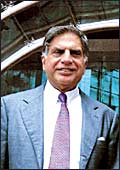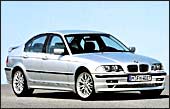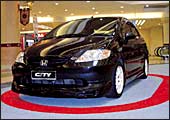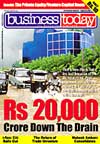 |
| Tata Tea's Siganporia: Ready
to take on the US market |
Celestial seasonings, honest Tea,
Tazo, The Republic of Tea, Traditional Medicinals, Stash Tea...these
are only a sprinkling of the hundreds of specialty tea brands
that are doing thriving business in the us. And that's where Tata
Tea- which is today entirely concentrated on brands, having defocused
its plantations business-now wants to be, with perhaps one or
two such brands in the bag. MD Percy Siganporia says the proposed
acquisition needn't necessarily be of a specialty tea (which are
typically value-added brewed beverages like herbal teas), but
could also be of the conventional variety, or of tea in the ready
to drink (RTD) form. "We are looking at acquisition opportunity
in the arena of tea in all its myriad forms. What we will be examining
is the scope for ensuring the business and the brand as a strategic
fit with our current portfolio and which allows us to grow the
business, thereafter," explains Siganporia.
Whilst the us tea market is relatively small in terms of tonnage
of black tea, it is one of the largest markets for tea sold as
a beverage, in the form of RTD brands, with double-digit growth
rates spurred on by consumers who've recognised the health benefits
of tea. Siganporia names two such brands, Snapple and Arizona,
which do much larger turnovers than most black tea brands. The
black tea segment is estimated to be as large as Rs 48,000 crore,
and the market for green, specialty and herbal teas and infusions
is just under Rs 50,000 crore. But it's the hot and cold beverage
format market- which includes everything potable, including colas-that's
the largest, estimated at some Rs 1,28,000 crore, and this could
well be where Tata Tea has trained its sights.
The US tea market isn't exactly consolidated, with just a handful
of significant acquisitions taking place over the past five-six
years. These include the buyout of Oregon Chai by the Irish-based
Kerry Foods, and Starbucks acquisition of Tazo Tea way back in
1999. Tata Tea could well be the next buyer in the us-it's received
shareholder approval for investing Rs 500 crore via its subsidiaries
to execute its acquisition game plan. Cheers to that.
-Brian Carvalho
VALUATION
Lots In A Name
 |
| Tata's Ratan Tata: Pricey
surname |
How much is your surname worth?
it may not be worth the exercise, but in the case of Ratan Tata,
it clearly is. In 1997, when the Tata Group carried out a brand
valuation exercise (involving TCS, Tata Tea, Indian Hotels, Tata
Steel and Tata Motors, and done by UK-based brand consultancy
Interbrand), the Tata name was worth $1 billion (Rs 3,600 crore).
Eight years on, its value has soared to $6 billion, according
to R. Gopalakrishnan, Executive Director, Tata Sons. (Rights to
the Tata brand reside not with Ratan Tata, but with Tata Sons).
Needless to say, the dearer brand is due to Tata's forays into
sunrise businesses like insurance and telecom, besides strong
performance in automobile and steel. The listing of TCS, too,
has helped. Says Gopalakrishnan: "The challenge before us in the
90s was to make the Tata brand contemporary and ensure that it
retained its basic values." A job well done.
-Krishna Gopalan
BMW In Chennai
The German car maker finally decides to invest
in a facility.
 |
| A BMW 3 series car: Finally,
stepping on the gas |
It was one of the last few car majors
that did not have a manufacturing presence in India. Even if belatedly,
BMW has moved to correct that anomaly. Last fortnight, the Foreign
Investment Promotion Board (FIPB) approved a proposal from the
German luxury car maker to invest Rs 100 crore in a facility in
the 'Detroit of India', Chennai. Initially, the company will import
completely knocked down (CKD) kits and assemble them at the new
plant. Depending on the sales volume, BMW is expected to ramp
up manufacturing. Although BMW has a strong image in the luxury
market (some consider it superior to the Mercedes marque), in
India, it will face stiff competition from the existing players.
The market for luxury cars is not just shockingly small, but also
slow to grow. According to the Society of Indian Automobile Manufacturers,
a bare 5,356 premium segment cars (where the BMW 5 series should
compete) were sold in 2003-04, with the number going up to 5,708
the next year. So far in this financial year, 1,764 of these cars
have been sold, representing a 6 per cent drop over the same period
last year. The market leader in this segment is the Honda Accord.
Therefore, it's unlikely that BMW will be in a hurry to invest
in expanding its manufacturing facility in India. "We cannot
comment on any concrete plans until our negotiations with the
government are closed. We are, however, definitely coming to India,"
says BMW's spokesperson Eckhard Wannieck.
BMW's belated enthusiasm has to do with India's potential as
a car market. While at one million units it is considerably smaller
than many markets in smaller European nations, it offers something
that few markets worldwide offer: Growth. "We don't think
we are late in entering the Indian market. We do everything step-by-step
and we now feel that there is potential in the Indian market for
the luxury cars that BMW makes," Wannieck says. BMW's challenge,
like in the case of other luxury car makers like Mercedes, is
to build a viable business in India.
-Rahul Sachitanand
AUTO
Load It Up, Baby
 |
| Hot wheels: Make mine top-end |
God may still not be in the business
of buying people a Mercedes (sorry, Janis Joplin), but that isn't
stopping buyers from picking the very best in their respective
segments. Take the Honda City, for instance. Around 60 per cent
of these cab-forwards sold are the fully-loaded, top-end variants,
never mind that at Rs 7,62,891 (ex-Delhi showroom) it's Rs 1.10
lakh more expensive than the base model. Ditto with the Honda
Accord. The automatic V6 alone fetches 45 per cent of the sales,
leaving the other variants to make up the rest. If you thought
only the buyers of expensive cars were less price sensitive, you
are mistaken. Hyundai Santro's higher end XG and XS account for
54 per cent of the small car's sales, and the Getz GLE, priced
Rs 60,000 higher than the entry model, accounts for more than
two-thirds of the model's sales. In the case of Maruti Swift,
the top-end ZXI, which comes with automatic climate control and
keyless entry, accounts for 30 per cent of the Swift sales, although
it is Rs 1 lakh costlier than the base model. What was that about
the 'price-conscious' Indian consumer?
-Swati Prasad
Cracking The Portability
Problem
Telecom solutions provider Siebel Systems
says it can be done, but at a cost.
 |
| Siebel's Drucket: Knows
the answers |
For sometime now, it has been the
mobile phone consumer's pet wish: a number that stays with her
as she switches service providers. Cellular phone companies, however,
have been ambivalent about such number portability, given that
it entails substantial investment in technology. The market, however,
seems eager. The number of cellular phone subscribers in India
has grown to over 60 million users, and quite clearly number portability
will ensure that the service provider with the best quality network
gains.
Solutions provider major Siebel Systems, in a white paper, outlines
factors such as network coverage, switching costs and penetration
levels that will affect number portability. "It has been
introduced in countries like the UK, Hong Kong and the us, where
the proportion of post-paid users is very large," notes Siebel's
Senior Vice President and General Manager (Communications, Media
and Energy), Reid S. Drucker. In fact, when it was launched in
Hong Kong and the US, as much as 95 per cent of the markets comprised
post-paid users. In India, the scenario is quite different, with
barely a quarter of the market being accounted for by post-paid
users. Understandably, number portability is easier to work in
a post-paid market since it has more user loyalty and a higher
level of stickiness. "In a prepaid market, you do not even
know your user and to that extent, it is difficult to have an
interface with him," explains Drucker. "Besides, how
many service providers will be willing to invest in number portability
if they were going to lose their subscribers in the process?"
asks a telecom official. That, in fact, is the biggest stumbling
block to number portability.
-Krishna Gopalan
R&D
IICT's Breakthrough Aviation Lube
 |
| IICT's Yadav: Certainly
worth the effort |
For a country with $144 billion
(Rs 6,33,600 crore) in foreign exchange reserves, saving on dollars
may no longer be the primary motive behind import substitution.
But the domain knowledge and self-reliance that such a strategy
affords still guides research at government-owned laboratories
in the country. The Hyderabad-based Indian Institute of Chemical
Technology (IICT) is a case in point. After spending Rs 17 crore
and a little over 12 months on the project, the institute has
finally developed a synthetic aviation lubricant that the country
currently imports. The Rs 100 crore in annual imports that it
will save is not the big pay-off. "The fact is that it has strategic
value and it can be produced indigenously much cheaper," says
IICT's Director, J.S. Yadav. The fuel is fairly unique for its
properties. It can withstand temperatures as high as 140 degree
C and as low as minus 40 degree C, and is made by a highly guarded
technology. So IICT's breakthrough is nothing to sneeze at.
-E. Kumar Sharma
The BT 50 Index
Between the highs and occasional corrections,
markets are likely to remain steady.
The rally in the markets has not
seen any significant movement over the last few days and the 8,000
mark still seems a while away. Barring a steep fall of close to
150 points, there have been no jitters and the consensus is that
there is still some breath left in this rally. The next few weeks
leading into the corporate numbers for the September quarter may
just end up being crucial.
Our flagship free float methodology-based index-BT 50-has completed
two years now. The free float methodology has several advantages:
first, it considers only the value of stocks freely available
in the market (after excluding the part held by promoters and
other strategic investors) and the weightage assigned to individual
shares is more representative than the market capitalisation-based
methodology; second, it takes care of the perpetual selection
dilemma regarding closely-held companies. For instance, the inclusion
of these companies may distort the index based on total market
capitalisation methodology, but dropping them altogether may reduce
its representative character. The free float methodology facilitates
inclusion of large closely-held companies but assigns them a lesser
weightage. After the success of our broad market free float index
(that the Sensex subsequently decided to adopt this is testimony
to the efficacy of the free float method), we decided to launch
sector indices using the same method. While the general index
captures the overall movements (covering several sectors), sector
indices capture the movements in individual sectors. All these
indices have a common base period (January 1, 2002). The weightages
are reassigned every quarter after companies declare their ownership
details. The base value of all BT indices is 100.
-Krishna Gopalan
|









